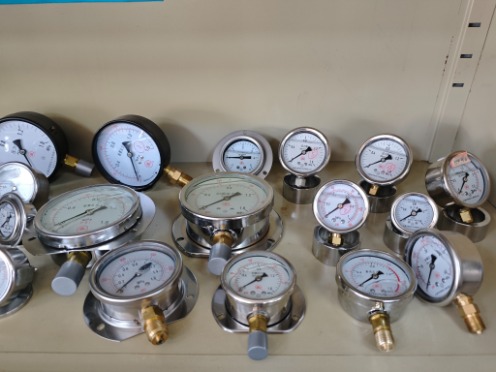Y series general stainless steel pressure gauge
Cat:Pressure Gauge
◆ Model: Y40 Y50 Y60 Y75 Y100 Y150 Y200 Y250◆ Use: This series of instruments is suitable for measur...
See DetailsA precision pressure gauge is an instrument used for high-precision pressure measurement. It typically has an accuracy level of 0.1 class, 0.25 class or 0.4 class (with error ranges of ±0.1%, ±0.25% and ±0.4% respectively), which is much higher than that of ordinary pressure gauges (1.5 class or 2.5 class). Its core features include high sensitivity, stability and long-term reliability.

Working principle and structure
1. Sensing principle:
Based on elastic deformation (Hooke's Law), the pressure action is transmitted through the spring tube or diaphragm, driving the gear mechanism of the movement to magnify the force, and then driving the pointer to display the pressure value.
2. Key Areas:
· Elastic elements: spring tube, diaphragm or bellows, the material should be corrosion-resistant (such as 316L stainless steel).
·Caliber: Gemstone bearings or frictionless structure, reducing transmission losses.
·Dial Plate: Gemstone bearings or frictionless structure, reducing transmission losses.
Typical application fields
1.Industrial inspection
·Test the ordinary pressure gauge (as the standard instrument).
·Pressure monitoring for compressors, boilers, etc.
2. Laboratory research
·Fluid mechanics experiments, airtightness tests.
3. Healthcare and Environmental Protection.
·Ventilator calibration, cleanroom pressure difference control.
Key points for use and maintenance
1. Installation Specifications:
·Avoid vibration or overload. When installed vertically, it should be level with the pressure-taking point.
·Corrosive media require the installation of isolation membranes or buffer bends.
2. Calibration cycle:
· Laboratory environment: Once every six months (in accordance with the JJG-49-2013 regulation)
·Industrial ambient: Once every three months.
3. Common Fault Resolution
· Pointer jamming: Check if the spring tube is clogged or if the gears are oxidized.
·Indication drift: This may be caused by sudden temperature changes or fatigue of the elastic element.
Future development
·Intelligentization: Integrating pressure transducer with IoT module to achieve remote monitoring
·Material innovation: Nanocoating elastic components enhance corrosion resistance.
·Multi-parameter measurement: Combined with temperature and flow sensors, it constitutes an integrated instrument.
Precision pressure gauges, as the "standard" in the field of pressure measurement, their selection and application should be based on the characteristics of the medium, environmental conditions, and precision requirements. With the advancement of Industry 4.0, high precision and digitalization will become the mainstream direction in the industry.
If you want to know more about the technical parameters of a certain type of precision pressure gauge, you can leave a message in the back saying "pressure gauge" to get a deeper understanding.